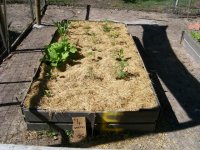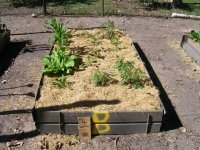You are using an out of date browser. It may not display this or other websites correctly.
You should upgrade or use an alternative browser.
You should upgrade or use an alternative browser.
charcoal retort
- Thread starter vince smith
- Start date
- Views: 9246
More options
Who Replied?
/ charcoal retort
#11
vince smith
Bronze Member
- Joined
- Mar 26, 2011
- Messages
- 55
- Tractor
- murray,s x2 Badboyx1, mf65 tractor
Hello pickstock, Google " puffergas" by Gary Gilmore as thats where I started he has some good instructions and pictures. He also has lots of information on different aspects of charcoal even into how they powered cars. I just made mine without having to cut holes in the drums and my way makes sealing the drums easier. Good luck.
Regards Vince Smith.
Regards Vince Smith.
vince smith
Bronze Member
- Joined
- Mar 26, 2011
- Messages
- 55
- Tractor
- murray,s x2 Badboyx1, mf65 tractor
Hello Igalaxy1372 which planet are you from ?..... Sorry, couldn't help having a joke.
Sorry mate but but I think it is exactly the opposite. It may well be the best carbon capture system available to mankind. If you mean the dust being harmfull, sure, I'm mindfull of any dust but it doesn't take much to work safely.
OLD, its old technology ( but improved ) I don't see that as sufficient reason to abandon it especially in favor of letting trees rot on the ground giving off gasses for years and years.
I see from your signature your not against cutting down trees and I would agree there are more knoble ways to use timber but this remains a very good use for otherwise worthless timber or for that matter any disgarded vegetable matter.
Regards Vince Smith.
Sorry mate but but I think it is exactly the opposite. It may well be the best carbon capture system available to mankind. If you mean the dust being harmfull, sure, I'm mindfull of any dust but it doesn't take much to work safely.
OLD, its old technology ( but improved ) I don't see that as sufficient reason to abandon it especially in favor of letting trees rot on the ground giving off gasses for years and years.
I see from your signature your not against cutting down trees and I would agree there are more knoble ways to use timber but this remains a very good use for otherwise worthless timber or for that matter any disgarded vegetable matter.
Regards Vince Smith.
Iplayfarmer
Super Member
I spent some time in Thailand. I recall every little farming villiage had at least one guy that made charcoal. They would stack the wood all pretty like, light it on fire, and then bury it with dirt. I remember thinking at the time that there had to be a better way.
Now I know what a better way looks like.
Satay just never tastes the same if it's not cooked over homemade charcoal in a clay pot.
Now I know what a better way looks like.
Satay just never tastes the same if it's not cooked over homemade charcoal in a clay pot.
desertmike345
New member
I made charcoal awhile back. Did some research and found a good post from my BBQ forum. Heres my burn. :licking:
:licking:
Mike
The Smoke Ring :: View topic - HOMEMADE CHARCOAL
Mike
The Smoke Ring :: View topic - HOMEMADE CHARCOAL
tcreeley
Elite Member
Re charcoal: North of me (Katahdin Ironworks) there is an old ironworks. Iron ore was mined and smelted into pig iron billets. The smelting was done with charcoal. The charcoal was made in large bee hive ovens with a vented top (stone etc), A smoldering fire was lit in the hardwood stacked inside and allowed to burn until it went out- several days. The result was charcoal that could burn hot enough to melt the iron out of the ore. This continued I think until the 1920's.
"Eric Sloane wrote about the importance of the charcoal makers to America's early history."
He did and made excellent drawings of old wrought iron tools. The colonial blacksmiths hand forged these tools, hammering them out on the anvil. Plows, carriage axles, pitch forks, hinges, kitchen utensils, etc. were all made using by blacksmiths using charcoal (home made) for fuel, with a bellows, forge, and anvil. As America became industrialized, soft bituminous coal (not the hard anthracite used for heat) was mined and replaced charcoal- efficient. I used to buy Pocahontas Pea coal, and Soule soft coal from West Virginia for forging. Great for forge welding. I've tried charcoal- works fine as well. (When the coals are glowing in the woodstove- that's the heat you want for forgework.)
The charcoal/soft coal imparts carbon to the wrought iron - giving rise to carbon steel and fancy damascus steel blades.
Charcoal is great stuff - but I prefer mine in the form of charred toast edges - gives it a certain taste- and if it is too charred- I just tell myself it's healthy!
Coke- is what you get when you use the same type of process in burning wood, but with coal. The impurities burn off and the coal cokes up. It is this coke that burns hot when you forge. As it is coking- there is a stickiness to the coal. This happens quickly with soft coal. It used to be that you could buy 2"-3" chunks of coke 1950's, 1960's made from anthracite by the ton. -Not so good for forging (really need a super blower), but fine for industrial types of use (smelting/drop forging).
Beehive kiln to make charcoal below - the smelter is to the left in distance (packed with charcoal and ore- melted iron ran out below.)
"Eric Sloane wrote about the importance of the charcoal makers to America's early history."
He did and made excellent drawings of old wrought iron tools. The colonial blacksmiths hand forged these tools, hammering them out on the anvil. Plows, carriage axles, pitch forks, hinges, kitchen utensils, etc. were all made using by blacksmiths using charcoal (home made) for fuel, with a bellows, forge, and anvil. As America became industrialized, soft bituminous coal (not the hard anthracite used for heat) was mined and replaced charcoal- efficient. I used to buy Pocahontas Pea coal, and Soule soft coal from West Virginia for forging. Great for forge welding. I've tried charcoal- works fine as well. (When the coals are glowing in the woodstove- that's the heat you want for forgework.)
The charcoal/soft coal imparts carbon to the wrought iron - giving rise to carbon steel and fancy damascus steel blades.
Charcoal is great stuff - but I prefer mine in the form of charred toast edges - gives it a certain taste- and if it is too charred- I just tell myself it's healthy!
Coke- is what you get when you use the same type of process in burning wood, but with coal. The impurities burn off and the coal cokes up. It is this coke that burns hot when you forge. As it is coking- there is a stickiness to the coal. This happens quickly with soft coal. It used to be that you could buy 2"-3" chunks of coke 1950's, 1960's made from anthracite by the ton. -Not so good for forging (really need a super blower), but fine for industrial types of use (smelting/drop forging).
Beehive kiln to make charcoal below - the smelter is to the left in distance (packed with charcoal and ore- melted iron ran out below.)
Last edited:
Sorry mate but but I think it is exactly the opposite. It may well be the best carbon capture system available to mankind. If you mean the dust being harmfull, sure, I'm mindfull of any dust but it doesn't take much to work safely.
OLD, its old technology ( but improved ) I don't see that as sufficient reason to abandon it especially in favor of letting trees rot on the ground giving off gasses for years and years.
Regards Vince Smith.
charcoal or BIO-CHAR is considered one of the best ways for carbon sequestation, also it is wonderfull for the garden and feilds.
once a tree has been chopped down, converted to charcoal more trees can be grown to take in more CO2
and yes i belive global warming is happening and theres nothing anyone can say that will change my mind
vince smith
Bronze Member
- Joined
- Mar 26, 2011
- Messages
- 55
- Tractor
- murray,s x2 Badboyx1, mf65 tractor
Hello all, Thanks for some interesting posts.
My post no 13 might not seem to make a lot of sense as the post I responded to dissapeared,and it sender it seems.
# tcreeley, yes as kids in the 50's Mum served up a lot of that sort of toast.
thank god we don't have to watch the toasters anymore.
# pickstock, I think the arguments to use it in gardens etc are compelling enough even for those that are not convinced about global warming.
(me included) I did some trials with home made bio char and chook poo and was happy with the results.
Regards Vince Smith.
P.S. bed B has bio char, bed e is the control.
My post no 13 might not seem to make a lot of sense as the post I responded to dissapeared,and it sender it seems.
# tcreeley, yes as kids in the 50's Mum served up a lot of that sort of toast.
thank god we don't have to watch the toasters anymore.
# pickstock, I think the arguments to use it in gardens etc are compelling enough even for those that are not convinced about global warming.
(me included) I did some trials with home made bio char and chook poo and was happy with the results.
Regards Vince Smith.
P.S. bed B has bio char, bed e is the control.
Attachments
Egon
Epic Contributor
Used to scrape the charcoal off of the remains of burnt wood from the smokehouse back when I was younger. Used it to make gunpowder.:thumbsup:
Used to scrape the charcoal off of the remains of burnt wood from the smokehouse back when I was younger. Used it to make gunpowder.:thumbsup:
oh how i wish it was legal to make gun powder in australia hahah


